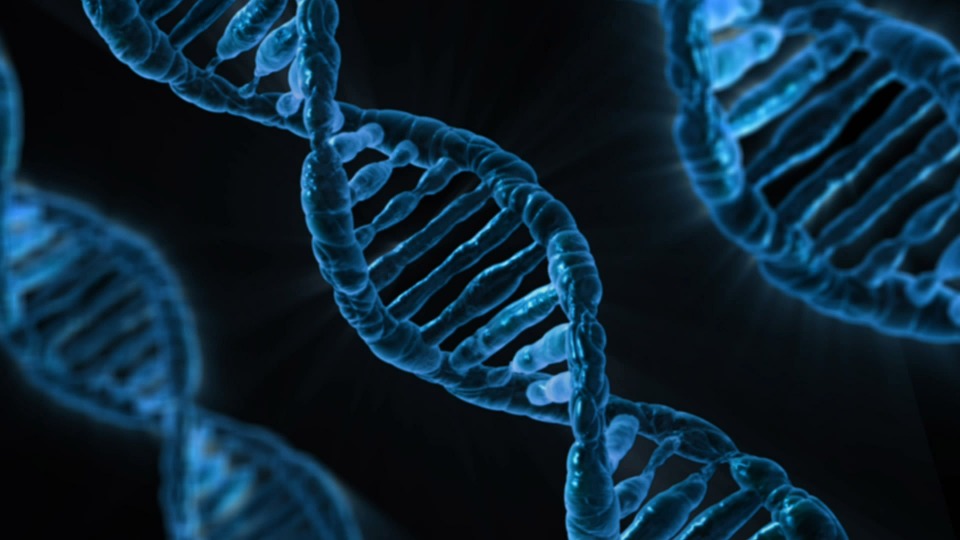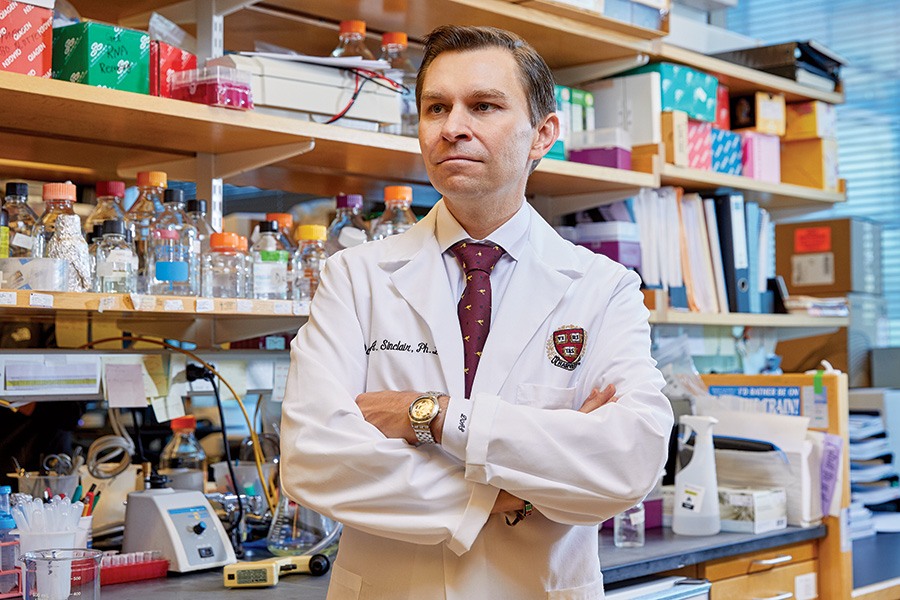Yamanaka Factors And Aging
Science • July 29, 2022 • 14min read
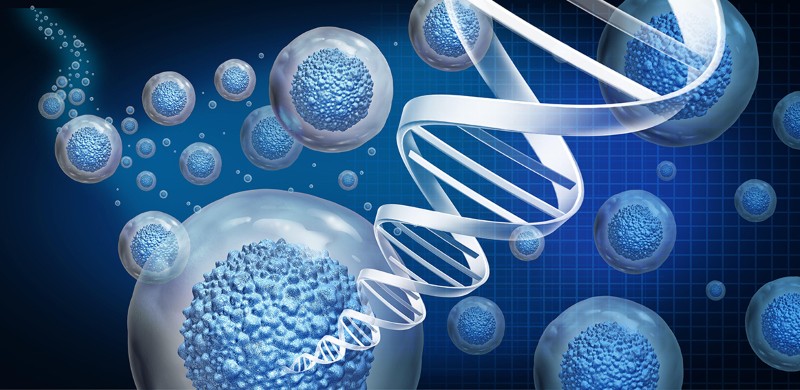
Highlights
- Yamanaka factors are a special type of proteins that can transform old or adult cells into very young (immature) cells in a process called “cellular reprogramming”.
- Under cellular reprogramming, the cell’s biological clock is regressed, resetting the biological age of the cell back to its earliest stage, like a stem cell (“age 0”).
- Rather than full cellular reprogramming, partial cellular reprogramming is more beneficial for rejuvenation to make cells younger, eliminating risks related to tumor formation.
- Treatment with Yamanaka factors successfully ameliorated damages that are previously thought to be irreversible – enabling subjects to regain vision, regenerate heart cells, reverse liver injury, or restore muscular regeneration.
- Yamanaka factors can safely reverse aging and extend lifespan in mice and can make human skin cells 30 years younger.
- NAD+ influences Yamanaka factors’ activity, suggesting that boosting NAD+ through NMN supplementation may support cellular rejuvenation, tissue regeneration, and biological age reversal.
Introduction
Aging is a slow, but sure process of degeneration.
Former anti-aging strategies focused on pausing or delaying the aging process, but recent innovations revealed a new, bolder strategy to turn back time.
One such strategy called Yamanaka factors has been awarded the 2012 Nobel Prize for Physiology or Medicine. This world-class prize is awarded to “those who, during the preceding year, have conferred the greatest benefit to mankind.”
Yamanaka factors are currently advancing the field of rejuvenative medicine. Research has successfully demonstrated its ability to reverse cellular states and age. With Yamanaka factors, you might finally regain your youth. And this means getting several years – or even decades – biologically younger.
In this article, we discuss what are the Yamanaka factors, their impacts on aging, and how it is advancing the current longevity development through cellular reprogramming.
What Are Yamanaka Factors?
Yamanaka factors are a special type of proteins that can transform old or adult cells into very young (immature) cells in a process called “cellular reprogramming”. The Yamanaka factors include Oct3/4, Sox2, Klf4, and c-Myc, also known as the OSKM proteins. These proteins are classified as “transcription factors” which are molecules that bind to our DNA to turn the genes “on” or “off”.
Like embryonic stem cells (the earliest cell states found from less than a week old embryos), iPSCs (induced pluripotent stem cells) are pluripotent – they have that kind of immature cell state that does not have any cell identity yet and can turn into any kind of cell type.
Scientific findings have revolutionized the biology of how cells and organisms develop. And more importantly, reveal that mature and old cells are not terminal, not irreversible, and they will pave the way to the future of cellular rejuvenation.
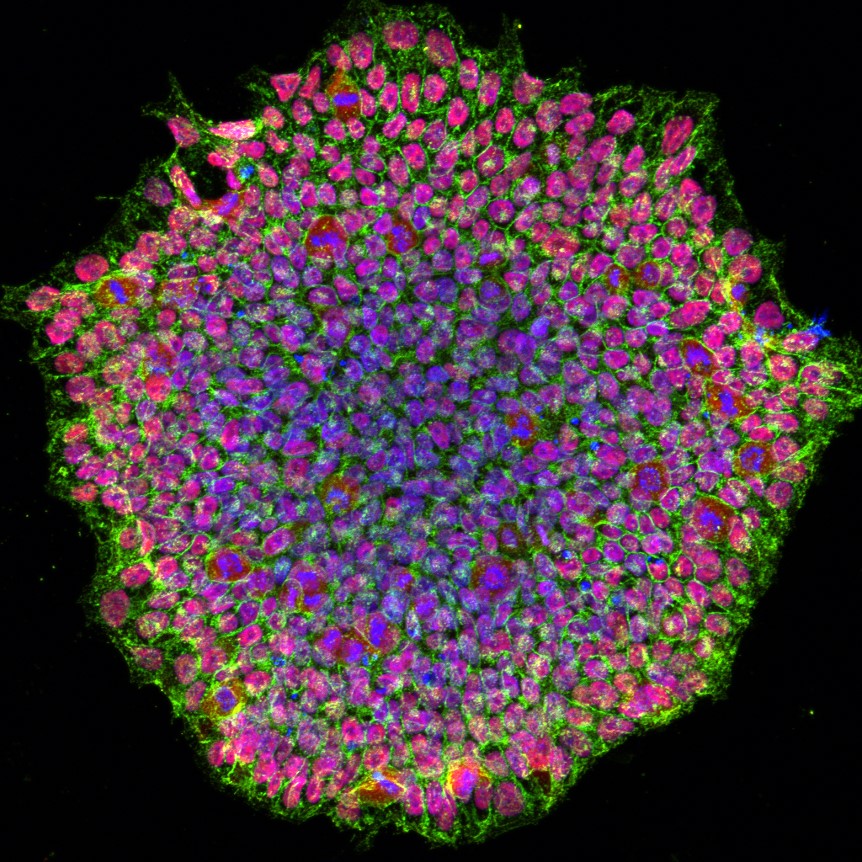
Microscopic image of iPSCs induced by Yamanaka factors. Image source
The earliest eureka moment was in 1962 when John Gurdon demonstrated that mature cells still contain the genetic instruction required to develop into all kinds of cells and develop into a whole organism. By replacing the nucleus of a fertilized frog egg cell with a mature cell (from the frog’s intestine), he proved that it can still develop into a new frog.
Fast forward to 2007, Yamanaka pinpointed the 4 transcription factors that are crucial to converting an adult cell’s state into a stem cell state and developed it into the iPSC technology.
Together, Gurdon and Yamanaka were honored with the Nobel Prize in Physiology or Medicine in 2012 for their groundbreaking discovery that mature cells can be reprogrammed to become pluripotent.
Yamanaka factors have also developed into crucial instruments in longevity research. Tight control of these factors is necessary as they can act as double-edged swords where excessive exposure might result in the erasure of a cell’s identity.

2012 Nobel Laureates Yamanaka and Gurdon. Image source
Yamanaka Factors And Effects On Aging
Since Yamanaka factors are transcription factors, they control how genes are activated or deactivated by binding to specific locations on the DNA where the genes are located. Further, they also alter the epigenome: modifications in the DNA that also control gene activation and deactivation. Most importantly, epigenetic changes are directly correlated with cell type identity as well as biological age
Epigenetic changes include methylation (addition of methyl groups) on DNA regions making the genes in that region unable to be expressed. This is because the methyl groups are blocking the binding of the enzymes that turn on the gene. Another example is histone modification.
Histones are natural protein scaffolds that DNA naturally wraps itself around as a packaging mechanism since the DNA is very long. Depending on chemical modifications on histones, the DNA can be in an “open chromatin state” where the DNA is exposed to enzymes ready to be read. Or it can be in a “closed chromatin state” where the DNA is tightly condensed so that enzymes cannot access and bind to it. Overall, these epigenetic marks are also correlated with the cell’s identity and biological age.
Studies show that the Yamanaka factors can rearrange or erase these epigenetic modifications leading to the loss of the cell’s identity and biological age, converting it into the immature, induced pluripotent stem cell state.
As an application, by using the power of Yamanaka factors, scientists are starting to restore human cells’ youth. They are optimistic that this can lead the way to the development of treatments for various age-related disorders.
The new strategy, which is based on the Yamanaka factors, overcomes the issue of completely deleting cell identity by stopping reprogramming halfway through the procedure. As a result, scientists can precisely strike a balance between reprogramming cells to make them biologically younger and restoring their ability to perform certain cell functions.
Yamanaka longevity research focuses mostly on understanding the genetic causes of aging so that one day it can be applied to modify or stop those aging causes. Many other paths need to be identified, but it remains to be seen whether or not any of them can be employed to stop, delay, or even reverse the aging process.
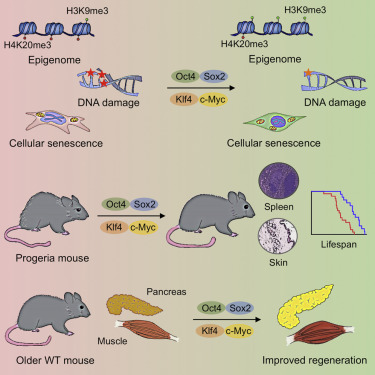
Treatment with Yamanaka Factors restores the epigenome, ameliorates cell senescence, increases lifespan, and improves organ regeneration. Image source
Yamanaka Factors, Rejuvenation, And Regeneration
After the discovery of Yamanaka factors and the development of iPSCs, recent developments in cellular reprogramming completely changed the disciplines of regenerative and rejuvenative medicine.
Today, iPSCs are being used in various disease therapies and have shown very promising clinical success in treating degenerative diseases.
Significant advancements in the field of cellular reprogramming have raised the possibility of using Yamanaka factors to simulate and cure human illnesses, especially those that are age-related. Cellular reprogramming makes it feasible to model illnesses, which is a great method to comprehend the processes and pathways behind the causation and progression of the disease.
Notably, rejuvenation and regeneration by Yamanaka factors do not only slow down damage and aging-related decline but rather reverse and restore the tissues of aged mice to a younger state.
In a breakthrough study conducted by Dr. David Sinclair’s team in late 2020, they revealed that Yamanaka factors can be used to regain vision. This time, they removed the c-Myc transcription factor from the cocktail because it is known as a primary pro-cancer gene. The researchers injured the eye’s retinal axon of the mice, impairing their vision.
Even though these mice had injured ocular nerves, their eyesight was restored by Oct4, Sox2, and Klf4 (OSK). It was the first ever data in the world that eyes can regain vision despite damaged retina and that OSK induces the rejuvenation and elongation of the retinal axons which are otherwise already previously believed as irreversible. To add more surprise, these new retinal axons have younger biological states as opposed to their originally old tissue before treatment.
According to Dr. Sinclair, “it is a permanent reset” and that this is a universal process that can be applied across the body to reset our biological age. It also helped mice treated for age-related visual impairment and animals mimicking glaucoma with elevated ocular pressure.

Optic nerve regeneration under OSK reprogramming restores vision. Image source
Yamanaka reprogrammed cells grow faster than aged cells from which they had been generated. In other words, reprogramming the cells allowed them to revert to a state more akin to early development that allows tissue regeneration and replenishment, and reversed certain features that characterize the hallmarks of aging.
Partial Cellular Reprogramming
Originally, Yamanaka factors are used for full cellular reprogramming – the conversion of old cells back into stem cells (iPSCs).
However, the process where Yamanaka factors revert an adult cell into iPSCs is similar to cancer stem cell reprogramming. This means injecting Yamanaka Factors directly into a person may invariably induce teratoma or tumor formation. Therefore, it is a major concern if these 4 transcription factors will ever be directly introduced to the human body.
To circumvent this, partial cellular reprogramming has been developed as a technique to rejuvenate the cells, and reset the biological clocks. This is done without pushing the age of the cells too much backward so that not to erase their cell identities, but only revert the aged cells to a younger state without complete reprogramming.
Overall, research confirms that cellular reprogramming could be an effective rejuvenation strategy and partial reprogramming shows promise in ameliorating age-related defects without tumor formation.
In an animal study of muscle regeneration, researchers discovered that muscle-wasting can be reversed using partial cellular reprogramming of human muscle stem cells. They also demonstrated that Yamanaka-factors-mediated transient cellular reprogramming can restore muscle regenerative capacity where treated aged mice have higher regenerated muscle fibers compared to untreated aged group as shown by an experiment on mice leg muscles below.
Consistently, microscopic investigation of the muscular tissues of the aged treated mice revealed amelioration of aging-related characteristics.

Yamanaka factors partial cellular reprogramming restore aged muscular stem cells’ regenerative capacity in mice. Image source
For liver regeneration, partial cellular reprogramming resulted in outstanding findings as well. Researchers used a liver injury model and confirmed that treating the injured hepatocytes (liver cells) with the four transcription factors (4F) reverses this damage, counteracts liver failure, and allows the regeneration and repair of the liver, as opposed to groups that did not receive the 4F.
The partially-reprogrammed liver acquired the early markers of youthful cell state and reduced expression of markers that define terminal cell states of hepatocytes.
In agreement with its activated ability to regenerate, markers of proliferation also increased. Most importantly, even though those hepatocytes are from livery injury mouse models, these mice had higher survival. In contrast, the mice untreated with 4F died rapidly due to insufficient liver regeneration.
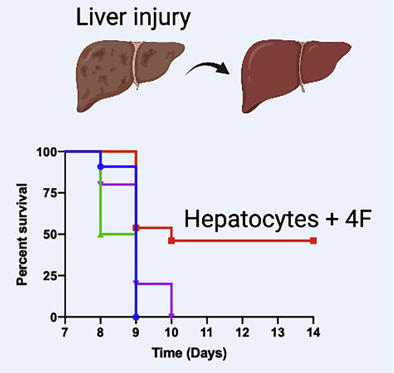
Partial cellular reprogramming enhances liver regeneration and
mouse survival under livery injury, while others died earlier. Image source
Another example where Yamanaka factors defy what was previously known as myocardial infarction (heart attack), a deadly medical emergency where heart muscles die due to a lack of blood flow and oxygen usually caused by blocked arteries.
It was previously believed that the heart can no longer regenerate after a heart attack or that it has a very limited regenerative capacity, and that the lost cardiac muscle cells are replaced by scar tissues called fibrosis burden the cardiovascular function.
But, evidence revealed that OSKM partial reprogramming can drive heart regeneration and repair of the damaged tissue after a heart attack. Reprogramming can therefore be curative, at least for specific tissues and organs in mice.
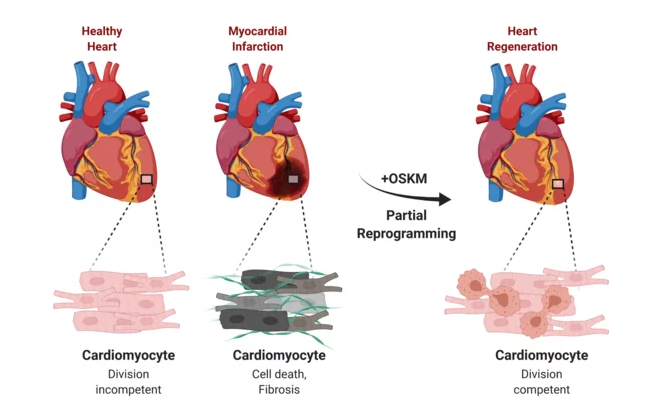
Treatment with Yamanaka Factors regenerates and repairs the heart after myocardial infarction. Image source
Yamanaka Factors And Nutrition
There are several more methods to delay aging and reset our biological clocks while we wait for science to establish if we can also reset our DNA. Endogenous stem cells may be used to enhance overall health and increase circulating stem cell counts if you are currently healthy and want to utilize stem cells as preventive medication but do not want to wait for stem cell transplantation in the future.
Our diets greatly impact our bodies’ natural regeneration cycles since food is medicine. Including foods that are good for stem cells in your diet is a great way to encourage the formation of your cells.
Here are some methods for increasing your natural stem cell count while still eating well.
- Superoxide dismutase (SOD), your potent cellular antioxidant enzyme, can be enhanced by berries, like blackberries, goji berries, pomegranate, blueberries, and raspberries. This enzyme is very effective in lowering oxidative stress, a process that plays an important role in maintaining good liver function and reducing joint discomfort.
- Certain compounds found in the mushroom called Ganoderma lingzhi can also stimulate neural stem cell proliferation.
- The healthy omega fatty acids and their metabolites from fishes and nuts are regulators of stem cell function and proliferation.
Intermittent fasting (IF) and calorie restriction (CR) are also modifiers that boost our stem cells. IF can boost the cells’ ability to regenerate and fasting in mice stimulates the stem cells to regenerate. It is also notable that CR can increase the number of stem cells and enhance stem cell function.
Yamanaka Factors, iPSCs, And NAD+
Meanwhile, scientists observed that NAD+ is critical to retaining stem cell pluripotency and stemness, making sure that your stem cells are active and powered. According to a study, it appears that there’s a high NAD+/NADH ratio in human iPSCs.
The researchers suggested that NAD+ is a crucial regulator of the stem cell pluripotency of iPSCs by promoting OSKM expression. Hence, boosting NAD+ via NMN supplements supports Yamanaka factors expression and activity, and iPSC development. In this line, NAD+ may prove beneficial to promote tissue regeneration and rejuvenation during Yamanaka cellular reprogramming.
Indeed, scientists also show that Nicotinamide (NAM) supplementation bypasses senescence and apoptosis and encourages cellular reprogramming during iPSC development. This is supported by other evidence about iPSCs’ and stem cells’ upregulation of NAMPT, the enzyme that converts NAM to NMN, and then to NAD+.
NAD+ was identified to be important in the survival of human stem cells. In contrast, when NAMPT is inhibited, Yamanaka factors Oct4, Sox2, and Klf4 decline, giving us a hint about their importance in Yamanaka factors activity.
Finally, mice NAD+ boost could induce the rejuvenation of neural, intestinal, and muscular stem cells, and was correlated with increased mitochondrial activity and lifespan.
The Future Of Yamanaka Factors
The most intriguing finding from Yamanaka factors is that it can reverse aging in human skin cells by 30 years. So one day, it might be uncommon to see anyone with wrinkles when everyone can reprogram their skin cells three decades back.
Finding a method to activate the Yamanaka factors in human cells without having to teach our systems to respond to a medication is the largest obstacle in transferring partial cellular reprogramming to individuals. To do this, we could create medications that can activate OSKM. Another option is to modify the germline so that our offspring are born with the ability to react to a certain molecule.
Finding a long-lasting therapy that does not require continual practice is the second significant obstacle to overcome. Because the aging symptoms reappear quickly, as was the case with mice after treatment interruption. It is crucial to find an affordable method to continue cyclic therapy. This might be done using medications or gene therapy.
Partial cellular reprogramming may hold enormous promise for avoiding or even treating aging-related disorders. One could imagine an early application of this strategy in the elderly at high risk of age-related diseases. They could receive partial reprogramming to slow or even stop aging.
In more advanced phases, it may be used in a more targeted way to treat a specific organ or tissue that has been harmed by disease or trauma. In a different, more specific scenario, elderly people’s bodies may be gradually rejuvenated to avoid age-related diseases completely, keeping them fit, energetic, and able to continue enjoying life.

Closing Remarks
Overall, current data and strategies support the effectiveness and safety of Yamanaka factors as a great candidate as an anti-aging therapy. With its capacity for reversal of tissue damage and degeneration, regaining youth, increasing lifespan, rescuing injured organs, or even re-writing the molecular patterns of the epigenome, it is undeniable that Yamanaka factors are defying the natural courses of aging and degeneration.
As promising candidates to safely reduce biological age, could Yamanaka factors cocktail be the real-life elixir of life? Based on current research, it could be. But a lot of real-world evidence and clinical trials are still needed to finally optimize and implement it.
No one can live forever, but everyone may live longer – healthily and normally.
So, the question is, are you ready to regain your youth?
Yamanaka factors are coming. Soon.

